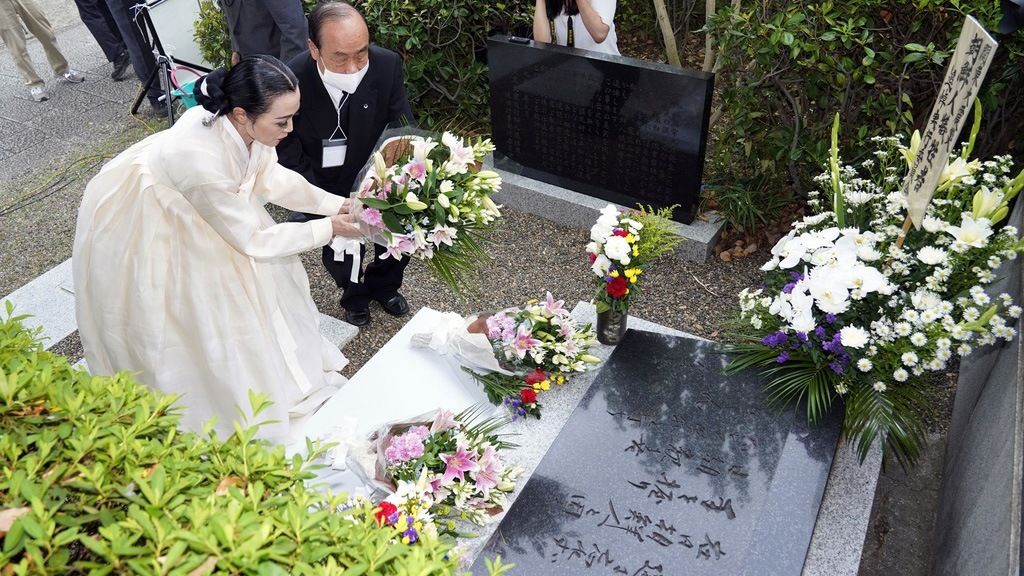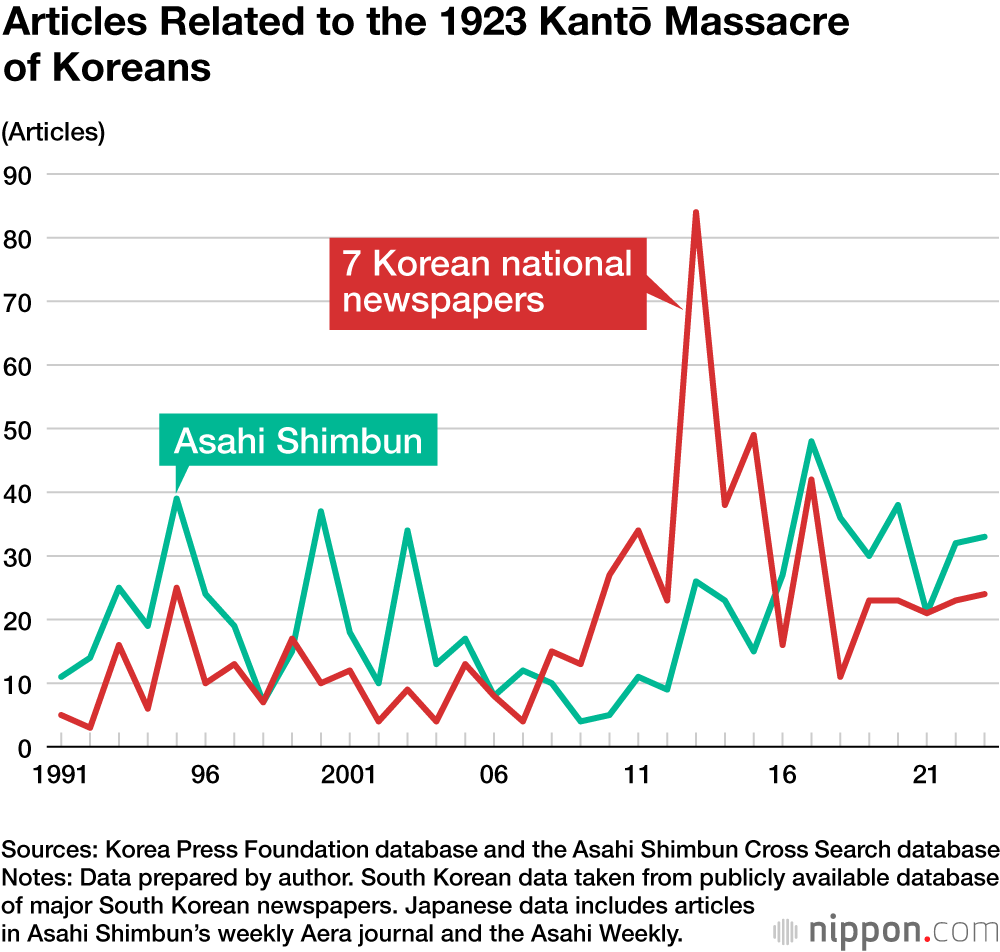
Memorializing Victims of the Kantō Massacre 100 Years On
Politics Society History- English
- 日本語
- 简体字
- 繁體字
- Français
- Español
- العربية
- Русский
Is the Past Truly Gone?
Issues of historical awareness are well-known for their intractability. This is despite these past events often being just that—events of the past that do not directly impact our lives. Sometimes there is little concrete benefit to be gained from dwelling on these issues, and doing so can in fact damage international relations and undermine the benefits that might otherwise be derived from historical reflection and reconciliation.
Of course, remembering the past is inevitable for those who suffered great physical and mental trauma. The pain of the past carries on into the now, and cannot be easily separated from our lives today. It is only natural for those directly involved in past tragedies to resent the events that deprived them of opportunities for a happier life and to seek redress to make the best of their situation.
In most cases, this is only while these people are still alive and actively speaking out on their own. Time moves away relentlessly from people’s experiences and memories, and at some point, even those directly involved will disappear. Nevertheless, people still dwell deeply on the past despite their lack of involvement, and even though no tangible and significant benefit will come from it.
Dynamics Shaping Historical Perceptions
When do such historical memories become prominent in public discourse? The figure below shows the frequency of news reports on one of these issues, the massacre of Koreans following the Great Kantō Earthquake of 1923.
Several things stand out from this figure. First, the milestone years of 1993, 2003, and 2013 see an uptick in reporting on the massacre. In these years, memorial services for the victims are held in various parts of Japan and South Korea, and the media publishes feature articles in response.
Political developments also stimulate media coverage in addition to the regular memorialization of events. For example, the peak in coverage in South Korea was 2013, not only due to the year marking the ninetieth anniversary of the Kantō Massacre, but also as the result of concerns surrounding the publication of Japanese teaching materials related to these events. Notably, 2013 was also a time of heightened interest in broader issues of historical recognition. In December 2012, the second administration of Prime Minister Abe Shinzō was formed in Tokyo, while the Park Geun-hye administration was formed in Seoul in February 2013. Issues regarding compensation and apologies for Korean comfort women would become particularly challenging.
The peak in Japanese coverage was 2017, however. This followed Tokyo Governor Koike Yuriko’s abrupt decision to not send an official written eulogy to an annual memorial ceremony for the massacre’s victims as previous Tokyo governors had done. The year 2017 was also politically significant as conflict deepened between the Japanese government and the newly formed progressive Moon Jae-in administration in Seoul. These political dynamics and the deterioration of Japan–South Korea relations clearly compounded underlying differences in attitudes surrounding historical memory of the Kantō Massacre.
Nevertheless, in 2018 and 2019, when there was further rapid deterioration of Japan-Korea relations, the issue decreased in prominence. The reason for this is easily explained: the focus of Japan-Korea relations during this period became the forced labor issue, which attracted attention with the ruling of the Korean Supreme Court in October in 2018, and the Japanese government’s response by implementing export control measures related to semiconductor products in July 2019. In other words, the increased prominence of these “contemporary” issues led to a relative loss of interest in the victims of the Kantō Massacre, an event that had occurred more than 90 years earlier.
Never-Ending Discussions
Clearly, for Koreans and Japanese, the events that took place almost 100 years ago surrounding the 1923 Great Kantō Earthquake are already an issue colored by contemporary events. There are no parties with direct memories of the Kantō Massacre, and the events only receive significant attention if linked to “current” issues such as revision of history textbook content or the cancellation of memorial services.
Outside of linkages to these contemporary controversies, the Kantō Massacre is in fact becoming a topic that is increasingly being looked at calmly. Unlike the comfort women issue and the forced labor issue, the events concerned happened 100 years ago, and there are no longer any individuals who have standing in court to pursue redress, or legal successors who have assumed such standing due to previous court decisions—at least at the time this article was written.
The comfort women and forced labor issues, by comparison, remain salient due to the movement of legal parties involved, including the bereaved families of those who were killed. However, even these people will eventually pass on. This raises the prospect that the situation surrounding the Kantō Massacre will soon come to characterize the situation of other controversial issues of historical awareness in the near future.
The problem is that, despite this inevitable development, the issues related to the Kantō Massacre still manage to create friction between Japan and South Korea through this linkage to the symbolic actions of current politicians and issues such as teaching materials. This shows once again that what we call the “historical awareness problem” is not so much a problem of the past itself, but a problem of the “present,” where various groups and individuals use the past to pursue contemporary political agendas.
An Undeniable Historical Fact
This also means that historical awareness controversies like this can only be addressed by changing the “now.” The massacre of Koreans at the time of the Great Kantō Earthquake is an undeniable historical fact—there are countless testimonies and historical documents attesting to it. Debate still rages on over the extent of the involvement and accountability of Japanese public authorities at the time, but not over whether the massacre itself took place.
The cruel fact is that people who emigrated to Tokyo, the metropole of the empire that colonized their homeland, to make a living for themselves, were massacred by suspicious locals after the unprecedented earthquake and tsunami. In the background of these events was the Sam-il Korean independence movement only four years earlier. People in Japan feared that resentful Koreans might take advantage of the chaos at the time of the earthquake to turn on Japanese themselves.
Nevertheless, the people killed were innocent, and irrespective of the degree of the involvement by authorities, it was a tragedy of the highest order perpetrated by Japanese people. That is why, to this day, various memorial events are held in connection to this incident throughout the Kantō region.
The Responsibility to Mourn
In Washington DC and London, there are large memorials recognizing the sacrifices and hardship of formerly colonized peoples mobilized for war or victims of empire. Citizens of these countries gather at these memorials to pay their respects. However, there are few similar opportunities for the Japanese public to recognize the hardships endured by people colonized by Japan.
Memorials for the Korean victims of the Kantō Massacre in Tokyo are therefore as valuable as memorials for Korean atomic-bomb survivors in Hiroshima and for Korean and Taiwanese victims at the Okinawa Prefectural Peace Park on Mabuni Hill. They represent one of the few opportunities for the people of Tokyo to explicitly recognize the sacrifices of people colonized by the Japanese empire centered on their city. After all, during the period of Japanese colonial rule over Korea and Taiwan, it was natural for Japanese people to pay their respects to both Japanese and colonized people mobilized to fight in Japanese wars and mourn the victims of tragic events throughout the empire.
This makes memorializing the Korean victims of the Kantō Massacre a true test of how Japanese people face their past and the victims of its events. There is no direct diplomatic involvement of a foreign government and no controversial court ruling to muddy the commemoration of this tragedy. We are therefore entirely responsible for our own choices about how to remember the event. If confusion arises because of that choice, we cannot blame anyone else. Whether or not we can truly put the past behind us is still ultimately up to us.
(Originally published in Japanese. Banner photo: People offer flowers at a memorial for Korean victims of the Kantō Massacre in Sumida, Tokyo, on the morning of September 1, 2020. © Kyodo.)
